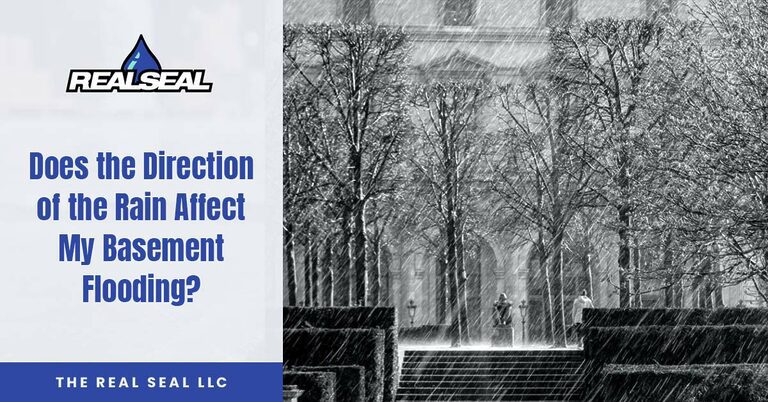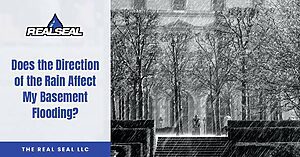When dealing with rain, we often can get turned around. Without measuring, we often make our own estimates as to how hard it rained or the severity of the flooding. Many times, we have been confronted with the phrase, “but it never did this in all the OTHER heavy rains!” While we believe this to be true, each rain is different, and therefore have different effects on the seepage in your basement.
Heavy rains can mean prolonged days-long rains or could be a 1-hour spurt that puts 3 inches of rain on the ground. Both can flood your basement, but they are not the same rains. Additionally, should we get those driving rains, the direction that rain comes from has a big difference on the placement of the water around your home.
Following the Path
Water is lazy. If you haven’t heard it before, you’re hearing it here. It is lazier than a pet rock. It simply goes where gravity, wind, and we (if you’re smart) take it. As it will literally come and go with the wind, we can easily see how driving winds will affect where the water ends up.
All of our weather comes from the West. Whether it be North or South, it is all from the West. This is due to the rotation of the earth (don’t get us started on flat-earthers). The major difference here is the North-South factor. When the storms come from the South, the South side of your home has a tremendous amount of water build up, but the North side will stay relatively drier.
It can be easy to see that if you have a general leak on the North side, the South-coming rain will not affect that leak as bad as North-coming rain. Additionally, a leak in your gutters on one side of your home can produce more water on that section of the foundation than the others. This causes more hydrostatic pressure, which can cause foundation issues.
Learn more about – Steps to Take After a Basement Flood
Preventative Steps
Great, thanks Austin. Another thing out of our control that we should be terrified about. Thanks. Not so fast! In fact, there is a LOT we can do about this. The first step is knowing. Once we are aware of the problem, we can take steps to lessen the affects.
- Gutters!!!
- Have we mentioned gutters before? YES, yes, a thousand times yes! It is vitally important to keep your gutters clear and the downspouts far (15’ minimum) away from the home. The average roof in America produces over 900 gallons of water in a single inch of rain. Get that water away from your home!
- Landscaping
- Although those raised flower boxes you just installed look reallllyyyy good against the house, if you did nothing to prevent seepage or allow drainage from those boxes, you may have created an issue. Water that builds in the flower boxes and stays against the home tends to cause issues with basement flooding. Also, grading the landscaping away from the home so water naturally slopes and falls away is important.
- French Drains
- Okay, Austin, I’ve done that stuff, but I still have lots of water pooling against my house, what now? At this point, we will want to install French Drains around the home, tying into Storm Drains preferably, can help move that water away from your home’s foundation.
Basement Floor Drains (Preventative Steps)
One of the best ways to help prevent basement flooding is to install a drainage system under your basement floor. This is called an interior drain tile system; its job is to collect excess moisture in the ground and carry it away from the foundation. Here’s the general installation procedure:
- The basement floor is broken up, and a shallow trench is dug around the inside perimeter of the basement and then lined with gravel.
- A perforated drainage pipe is placed in the trench and covered with more gravel.
- The basement floor is replaced.
Any excess moisture in the ground will flow into the drainage pipe and toward a sump pit. When the sump pit fills with water, a sump pump will turn on and eject the water away from the foundation. We recommend expelling the water at least 15 feet from the foundation.
Taking Action Over Inaction
It is always better to take action than to sit still. Water cares little for our indifference and hope. If water came in, it can come in again. You can also check if water is coming up from your basement and take measures to prevent water from coming up from the basement floor. The best thing we can do is get ahead of it BEFORE the next major rains hit. Calling and discussing with a professional, reputable contractor in your area is vital. Check Reviews, read testimonials, and make certain you have the correct company coming out to perform the work. This preventative work can work, but only if installed correctly.
Thanks for reading, and as always:
“Not Everything’s Better When Wet”







2 Responses
I guess the direction of gutter affected the flooding in our place. I also got tips from this site knowing I have to consult for basement flooding solutions newton massachusetts. Will follow more of your content!
Thanks so much, William! We’re happy to help!